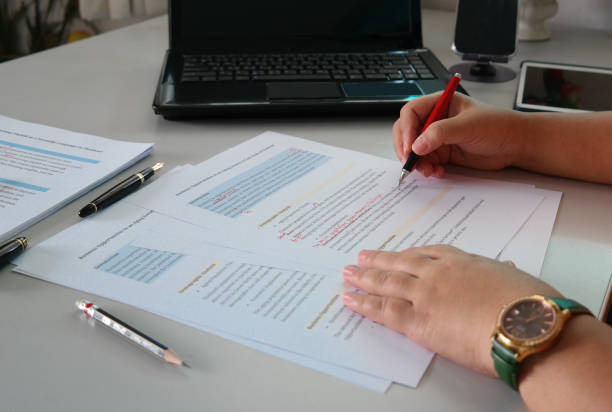Many students consider the final full stop as the end of the writing process. However, the true magic happens afterward. Self-editing is the critical, often overlooked phase that transforms a good draft into an excellent, submission-ready piece of coursework. It is where you shift from being the writer to becoming the reader, critically evaluating your work for clarity, coherence, and impact. Even services offering the UK’s Best Tourism Coursework Help emphasise that a student’s own editorial review is irreplaceable for achieving top marks.
Why Self-Editing is a Non-Negotiable Academic Skill
Self-editing is far more than just correcting typos. It is a disciplined process of refinement that elevates the quality of your arguments. By meticulously reviewing your work, you ensure your ideas are communicated with maximum clarity and persuasiveness. This demonstrates respect for your reader, typically your professor, and shows a commitment to academic excellence that goes beyond merely completing the assignment.
Furthermore, effective self-editing directly impacts your grades. Professors assess not only the content but also its presentation. A well-structured, error-free paper is easier to read and signals thoroughness and intellectual maturity. It allows your brilliant ideas to shine without being obscured by avoidable mistakes in formatting, grammar, or logic, making a strong positive impression on the evaluator.
The Multifaceted Process of Self-Editing
A common mistake is trying to tackle every editing aspect at once. This leads to oversight. Instead, break the process into distinct, manageable stages. Each pass should have a single, focused objective. This systematic approach ensures you pay attention to every element, from the overarching structure down to the minutiae of punctuation, making the entire process more efficient and effective.
Stage 1: The Structural Edit (The Macro View)
Begin with the big picture. Examine your coursework’s overall structure and argument flow. Ensure your thesis statement is clear and that every paragraph directly supports it. Check for logical transitions between sections and confirm your conclusion effectively synthesizes your main points without introducing new information. This stage is about strengthening the backbone of your argument.
Stage 2: The Paragraph-Level Edit (The Meso View)
Next, scrutinize each paragraph individually. Each one should present a single, coherent idea, often signaled by a clear topic sentence. Evaluate the evidence and examples provided within each paragraph are they relevant and convincing? Ensure sentences within a paragraph logically connect to one another, creating a smooth and persuasive narrative that builds your case step-by-step.
Stage 3: The Sentence-Level Edit (The Micro View)
Now, focus on crafting clear and concise sentences. Eliminate wordiness, redundancy, and awkward phrasing. Vary your sentence structure to maintain reader engagement and improve rhythm. Read sentences aloud to catch clumsy constructions. This stage polishes your language, ensuring every sentence contributes effectively and elegantly to your overall message.
Stage 4: Proofreading for Grammar and Mechanics
The final stage is proofreading for surface errors. Meticulously check for spelling mistakes, grammatical errors, incorrect punctuation, and inconsistent tense. Also, verify adherence to the required citation style (APA, MLA, Chicago, etc.) for in-text citations and the bibliography. These small details, when correct, lend professionalism and credibility to your work.
Practical Self-Editing Strategies for Students
Always create distance between writing and editing. If time permits, leave your draft for a day or even a few hours. Returning with fresh eyes will make you more objective and likely to spot errors, weak arguments, and unclear sections that you were blind to immediately after the intense focus of writing.
Reading your work aloud is a surprisingly powerful technique. It forces you to process the text more slowly, helping you catch run-on sentences, awkward phrasing, and missing words that your eye might skip over when reading silently. Your ear will often detect clunky rhythm and poor flow that your eyes miss, highlighting areas that need smoothing out.
Do not rely solely on spellcheck. While useful for catching blatant errors, it can miss context-dependent mistakes like homophones (e.g., their/there/they’re). Consider using text-to-speech software to hear your paper read back to you. This provides a different perspective and can be excellent for identifying areas where the writing sounds unnatural or confusing.
Overcoming Common Self-Editing Challenges
A major hurdle is psychological attachment to your writing. You may hesitate to delete a well-phrased sentence that doesn’t quite fit. Combat this by remembering your primary goal: clear communication. Be ruthless in cutting content that doesn’t serve your argument, even if it’s “good.” Every sentence must earn its place on the page.
Time management is another significant challenge. Students often finish drafts at the last minute, leaving no room for proper editing. To overcome this, plan your schedule backwards from the deadline. Allocate specific, non-negotiable blocks of time for each editing stage. Treat these editing sessions with the same importance as the initial writing time to ensure your work gets the polish it deserves.
Conclusion: Making Self-Editing a Habit
Self-editing is not a last-minute chore but an integral part of the scholarly writing process. By embracing a structured, multi-stage approach, you take full ownership of your work. This habit transforms you from a passive participant into an active, critical thinker and communicator. The result is not only higher grades but also the development of a crucial skill that will benefit all your future academic and professional writing endeavors.
(FAQs)
Q: How is self-editing different from proofreading?
A: Self-editing is a comprehensive process focusing on structure, arguments, and clarity. Proofreading is the final stage, focusing solely on surface errors like spelling and grammar.
Q: Can I just use Grammarly instead of self-editing?
A: No. Tools like Grammarly are aids for proofreading and style suggestions. They cannot evaluate the logic, strength, or coherence of your overall argument, which is the core of self-editing.
Q: How long should I leave my draft before editing it?
A: Even a short break of a few hours can help. Ideally, leave it overnight to return with a fresh perspective and a more critical eye for spotting issues.
Q: What is the most common mistake students make when self-editing?
A: The biggest mistake is trying to fix everything at once. This leads to overlooked errors. A staged, focused approach is far more effective and reliable.
Q: Is it okay to edit on the screen, or should I use a printed copy?
A: Both are valid, but changing the medium can help. Printing your work allows you to see it differently and often helps in catching errors you might miss on a screen.


